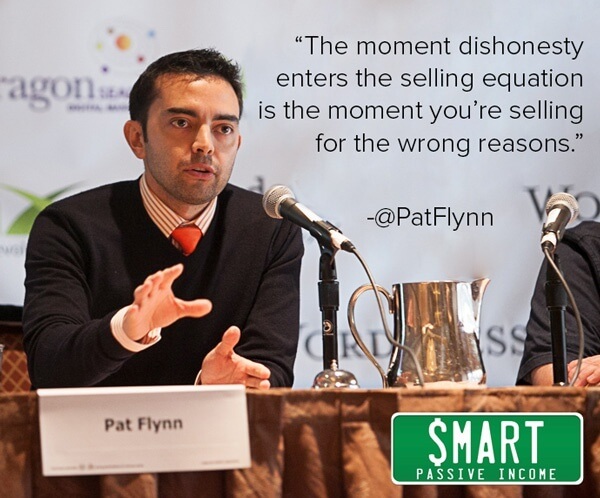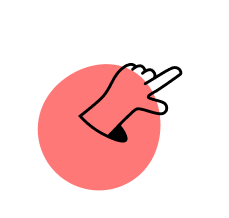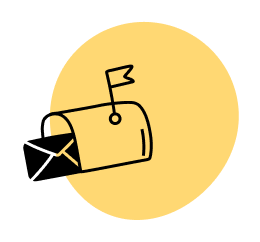One of the hardest things to do is hit a baseball thrown by a major league pitcher (especially if you’re on the San Diego Padres). From fastballs traveling nearly 100 miles an hour to curveballs and everything in between, it’s difficult to make contact with the ball, let alone get a hit that actually counts.
Now I want you to imagine a baseball game played by five year olds. If five-year-old kids had to swing at normal pitches, the game wouldn’t be any fun. So to help, the pitcher is removed, and the ball is simply placed on a tee next to the kid, just above belt level.
“Swing away when you’re ready!”

This is known as teeball, and it’s awesome to give kids the chance to hit a baseball that typically, at least at that age, would be impossible to make contact with if it was moving.
Some of my earliest childhood memories involve playing teeball, like that one time the ball went between my legs and I gave up a winning run.
So, what’s with the baseball/teeball reference?
Well, in online business, a lot of people are sending their audience too many fastballs—pitch after pitch and offer after offer, with only little time to react before the opportunity to swing is missed.
I’m on a few email lists where I’m getting pitched a new, highly-priced info-product every couple of days! I stay subscribed to these lists and succumb to the bad taste in my mouth just so I can stay on the leading edge of what not do.
In this post, I’m going to show you how you can “slow down your pitches” and get it to a point where essentially what you’re doing is teeing up buying opportunities for your audience.
I’ll show you how you can use non-aggressive selling strategies to take the pressure off of your audience and make things even more convenient for them.
Over the course of 5 years of blogging, “teeing it up” is what has been most successful for me. I’ve earned over a million dollars without the use of aggressive selling tactics, product launches or upsells.
Before I go on, it’s important that I mention this:
I’m not against hard selling and aggressive pitches.
As Derek Halpern says, “I don’t sell often, but when I do, I sell hard.”
And if you’ve created something amazing that you know will change the lives of your audience, you should sell hard too.
If you created a cure for a disease, you wouldn’t soft-sell it, you’d sell it hard!
Why?
Because the more you sell, the more you know you’re actually curing this disease.
What I am against is not being truthful—both in terms of what is being offered, and how it’s being offered (like false scarcity). There are nice ways to sell hard, and there are not-so-nice ways to sell hard.

There’s a time and a place for an honest hard-sell, but in-between there are several passive income opportunities for you which you can setup to run long-term on your site, and all it takes is “teeing it up”.
Here are some strategies and tactics you can use to help “tee it up” for your audience and sell without really selling at all.
The “Free-Way” Method
Some of my most successful promotions for products came as a result of showing people exactly how to do what that product does, for free.
Say what?!
Let me give you an example…
I ran a free webinar a few years ago about keyword research, which involves data-mining Google for searched terms and dissecting the results for possible niche site opportunities.
This is how SecurityGuardTrainingHQ.com, as well as FoodTruckr.com came to be.
During the webinar, I spend the first 10 minutes going over what makes a good keyword and exactly what we hope to find during our research.
Then, I share exactly how to do it…for free.
I reveal step-by-step, exactly how one can conduct keyword research on their own using free tools available on the web, without having to pay a dime.
Sharing the free-way is important for a couple of reasons:
- You’re giving those who aren’t ready to pay for a premium tool an opportunity to move forward. They can get started right away, risk-free. This also gives them an opportunity to see what it’s like, which plays along with the second reason…
- It helps to contrast and illustrate the benefit of investing in a product, tool or resource that could get the same (or better) results, with just a fraction of the time and effort.
When you share the free-way, and then immediately follow with the benefits of a paid solution (whether it’s your own or someone else’s) it clearly shows why that product exists, and proves that it works.
There is no hard-selling required. The contrast, if big enough, will do all of the selling for you, and if you’re addressing a pain that your target audience has, then you’ve successfully teed it up for them.
Here are a few other examples of how I’ve teed it up in the past:
- I’ve contrasted creating a landing page manually on a WordPress site with the ease and convenience of doing it with LeadPages. [Full Disclosure: I’m a compensated advisor and affiliate for LeadPages.]
- I’ve discussed the process of manually hiring a VA, versus the experience I’ve had using Chris Ducker’s Virtual Staff Finder service.
- On greenexamacademy.com, I mention that most of the information in my ebook is freely available on the website, but I clearly contrast going page by page on the web versus the convenience of instantly downloading (and printing) a nicely formatted ebook.
Not all products will have a free-way of achieving a similar result, but when they do, consider just giving that information away, because if the product you’re promoting is truly awesome, then the product will essentially sell itself.
Opening Your Books
Opening your books, or having an open door policy, is exactly what this site has become known for.
As much as I possibly can, I run experiments and share every part, step, result, thought, and penny along the way. Sometimes things go well, and sometimes they don’t—but it’s always a lesson worth sharing.
During these experiments and along these various journeys that I’ve taken and shared, I happen upon several different tools and resources that help me move forward.
Sometimes these tools are free, and sometimes these tools are not. Doesn’t matter, I’m sharing them, because I’ve used them and they’ve helped.
Sometimes the tools that are not free have an affiliate program, and sometimes they don’t. Doesn’t matter, I’m sharing them, because I’ve used them and they’ve helped.
When there is an affiliate program, however, if it’s a product that has helped me, I’ll sign up, and when I mention that product in my reports or tutorials, I use that affiliate link, and I mention that it’s there too.
When you reveal your entire process, and the tools you use along the way, a number of things are happening:
1. You’re building trust.
Since you share it all—including the things that don’t go so well—your recommendations are actually trusted even more. You’re not pretending to be someone you’re not, you’re just you and you’re just sharing what you’ve done.
2. Human psychology plays a role.
Something interesting happens in our brains when we as humans observe something.
We have these bundles of cells in our brains called mirror neurons that work in our favor. According to Wikipedia:
A mirror neuron is a neuron that fires both when an animal acts and when the animal observes the same action performed by another. Thus, the neuron “mirrors” the behavior of the other, as though the observer were itself acting.
Wikipedia
This is the reason why your mouth will water when you see (or even imagine) someone biting into a sour yellow lemon.
Your mouth is probably watering right now because of what you just read, meaning you don’t necessarily need video in order to connect with people in this way—you just need the right set of words and descriptions.
When you reveal a process, especially in great detail (such as through video or with images), an observer can’t help but imagine themselves going through that process too—actually touching or clicking or moving in the same way you are.
When you reveal the tools and resources that you use along the way, if the content is useful they’ll want to use the same tools and resources as you too.
3. Beyond all of that, you’re showing people what they’re going to get.
Show people what they will get before they get it, and how it is to be used once it’s in hand. Eliminate the fear of the unknown.
4. You’re not directly selling anything.
You’re sharing a process and happen to be mentioning the products you’ve used help you along the way. Again, you’re letting the results of what you do with these tools and resources do the selling for you.
5. Because not everyone opens their books and reveals everything, you’re more likely to stand out of the crowd and be shared.
When your epic content gets shared, that means more opportunity to build trust, and more eyes on your case study and the products you mention within it.
Here is a list of examples of case studies, experiments and methods revealed in major detail (along with their viewership, to show sharability of this type of content), which mention products as an affiliate along the way:
- The Entire Niche Site Duel 1.0 and 2.0 Series
- Pat’s Step by Step Guide to Starting a Podcast (124,558 pageviews)
- The Beginner’s Guide to Starting a Newsletter (95,534 page visits)
- Ebooks the Smart Way (84,012 downloads)
- All of My Monthly Income Reports (overall report page: 627,236 visits)
- Creating iPhone Applications (86,309 downloads)
- How to Make an Electronic White Board (video viewed 28,048 times)
There are a lot more, but as you can see, I’ll often pick a topic, go into major detail with it, and then just share everything that happens, and anything I use to help me along the way. This is very shareable stuff, and again—no pitch.
Look—I’m a terrible copywriter.
I cannot write great sales copy, which is why I let the products I use, and their results, speak for me instead and tee these products for me. And even if I could write great sales copy, I’d still let my products do the talking for me.
I feel much better having my audience make buying decisions on their own based off of real life results, then hype or exaggeration or a “YOU NEED THIS NOW” from me.
If You Don’t Have This Page on Your Site, You’re Crazy…

There’s one page on SPI that is the most profitable page on the site. If you don’t have a page like this, you’re missing out, and not just on possible income, but the ability to give your audience something completely helpful and convenient without you ever having to do anything after you’ve set it up.
What is it?
A resource page.
A resource page is a page on your site that lists any tools, links and resources that your audience would find useful, preferably ones that you’ve already mentioned on your site before.
Here’s a link to my own resource page on this site.
I also have a Best of Smart Passive Income Page, which is where I’ve organized the most important articles and podcasts published on the site. It’s similar and you could combine the two, but I like to keep them separate because it would be too overwhelming with both.
My own resource page accounts for over 60% of the overall income generated from this blog, and the beauty of it is that it’s passive and perpetually more and more profitable.
It’s not aggressive at all, and in fact people arrive on this page and think it’s a goldmine of information—all of the good stuff, conveniently in one spot.
Which it is.
And that’s how you want to approach the creation of this page and the tools and resources you choose to put on it.
Here’s how to make a resources page work best for you:
1. Create a new page on your site.
You can call it resources, tools, whatever you wish, but just create a new page.
2. List any items that you’ve ever mentioned (or plan to mention) within your brand that could be considered a resource.
These could be products, tools, links, resources, books, software, equipment, other blogs and podcasts, etc.
If they are your own creation—great. If they are someone else’s creation, awesome.
If it’s someone else’s creation and it comes with an affiliate or partnership program—great. If not, you should still put it on the page anyway.
Remember, this page is supposed to be as helpful and convenient as possible, and not everything that is helpful will directly generate an income for you.
It’s not about the income. It’s about the convenience and library of awesomeness you’re creating for your audience, and the more awesome it is—well—the more trust and earnings you’ll have in the long-run.
3. Use icons and thumbnails of the product or product logo, when possible.
This helps make the page look more appealing and professional as one scrolls down and scans the page.
4. If possible, organize the list of items by type.
Again, this makes it easier to scan through and find something useful.
5. Include the blog posts, podcast episodes and any other related articles you might have published relevant to the items that you list.
For example, when I mention LeadPages on my resource page, I share a link to this free webinar replay for that particular tool, which of course promotes the tool even further, but also adds more value at the same time.
It also gives people an opportunity to see what they’re going to get before they get it, which is huge—especially when promoting a product that is not your own.
6. Throughout your website: in the sidebar, within articles, at the end of podcast episodes, on guest posts, etc., mention your resource page.
Even when you mention specific products on individual blog posts, you can cross-reference and drive traffic back to the the resources page as well.
Over time, you will get to a point where no matter what page on your site visitors arrive on for the first time, they will eventually get connected to your resource page.
Remember, this is a long-term strategy, and because of that, you don’t need to push hard at all. Make this awesome, and it’ll attract more people on its own.
It’s a win for everyone.
To Finish Up…
I hope you can see the benefit of approaching sales in this way. It provides a long-term, passive approach to allow your audience to discover products that are helpful to them, on their own, as they go through your site and get deeper into your content.
Discovering buying opportunities using these strategies will not only help your earnings, but the trust you build with your audience too.
Like I said earlier, I’m not opposed to the hard-sell, as long as it’s honest, and in a perfect world you’d have products “teed up” throughout your site, while also running strategically timed (and time-sensitive) launches for key, flagship products.
I’d love to hear your thoughts in the comment section below. What do you think about hard-sell approach versus passive selling strategies like what I outlined in this post? Are you opposed to one or the other—or both? Which have you tried and did it work for you?
Please share and discuss below.
Thanks as always! If you like this post, please consider sharing it by quickly tapping one of the social share buttons below.
Cheers!



